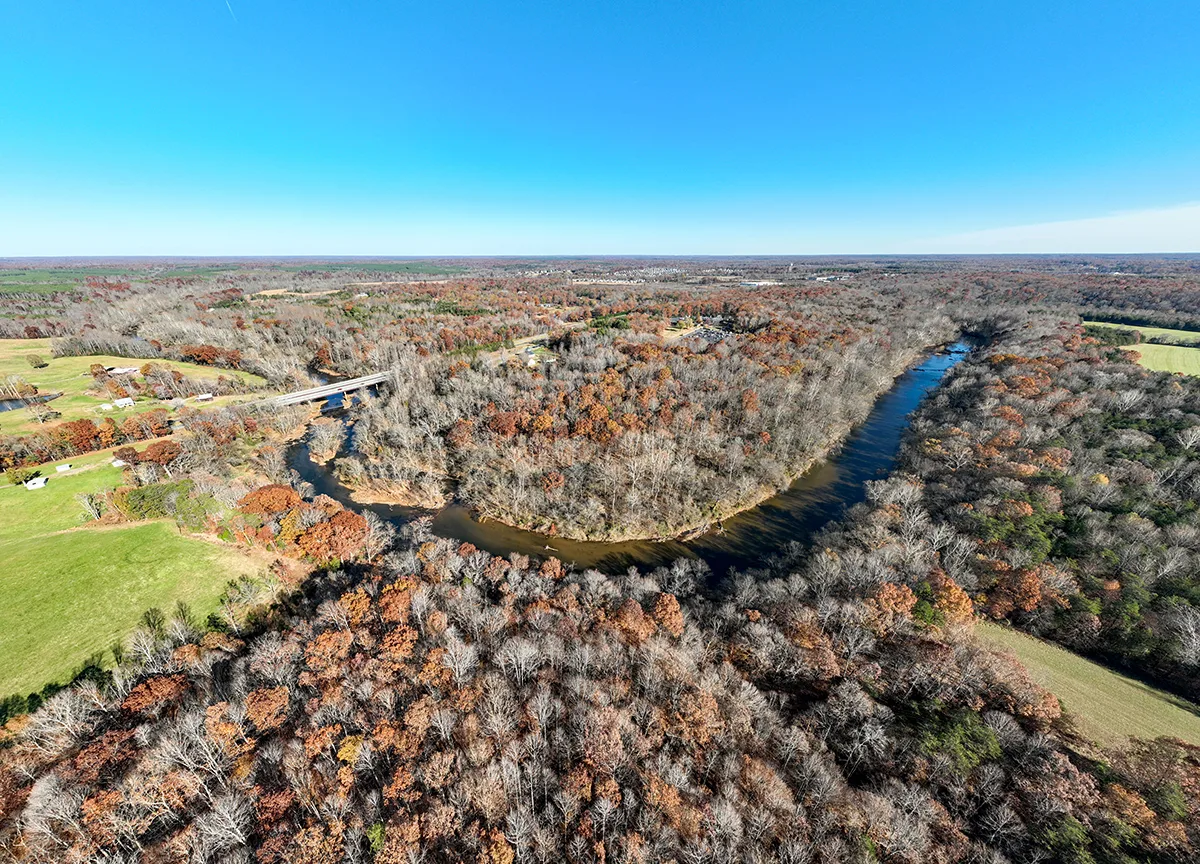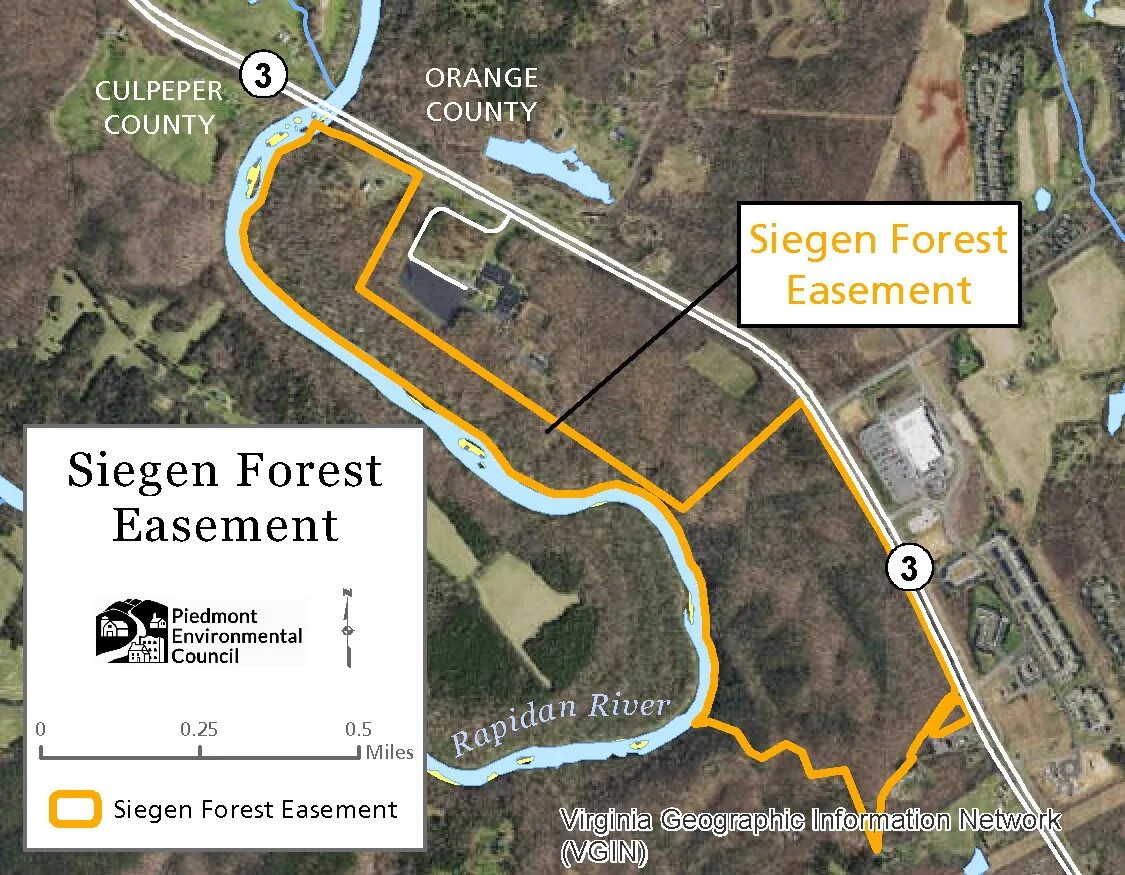In Locust Grove, an old woods meanders some 1.4 miles alongside the banks of the Rapidan River, on the Orange County side, between the river and State Route 3. Its dense canopy provides and protects habitat for state-threatened species and shades a network of public trails beneath. Through the woods’ 172 acres, the trails reveal a natural floodplain that makes the area more resilient against intense storms and a wetlands with nearly 200 feet of vegetation buffering the shoreline, helping keep clean Rapidan waters that will eventually flow to the Chesapeake Bay.

These woods are called Siegen Forest, and they lie within what was the first German settlement in colonial Virginia. Germanna, and Siegen Forest, got their names from the 42 German immigrants who crossed the Atlantic from the Siegerland area of Germany in 1714, and the 20 families that followed three years later. This westernmost outpost of colonial Virginia at the time drew workers from their native German principality of Nassau-Siegen to mine for iron.
A shallow river crossing here, still called Germanna Ford, later bore witness to the Civil War, as it was one of few places along the Rapidan River where large groups of infantry and cavalry could cross quickly. Siegen Forest saw the Army of the Potomac’s surprise defeat in the Battle of Chancellorsville in 1863 and U.S. Colored Troops fight bravely during the inconclusive Battle of Wilderness a year later.
Owned by the nonprofit organization Historic Germanna since 1956, Siegen Forest today holds rich ecosystems of flora and fauna and several archeological sites that provide insight into early German immigrants and 18th century-Native American and African American histories on the land. The area’s deeply layered past and the woods’ rich natural and recreational resources make last year’s permanent conservation of Siegen Forest an achievement worthy of celebration.
On Oct. 27, 2023, Historic Germanna’s executive director, Jennifer Hurst Wender, and board president, Keith Hoffman, signed a perpetual open-space easement on Siegen Forest. The easement is held by the Virginia Board of Historic Resources. “This is a project that has been many, many years in the making and involved the partnership of so many different organizations, probably going back at least a decade,” said Maggi Blomstrom, PEC’s Rappahannock-Rapidan conservation coordinator. “Owning land is expensive, and Historic Germanna was exploring ways it could both protect the property and raise funds to reinvest in its care and into the organization.”
Kristie Kendall, formerly PEC’s historic preservation coordinator and Historic Germanna board member, introduced the organization to the possibility that a conservation easement could potentially support both goals. The journey that followed involved extensive research, meticulous planning, and thoughtful conversations and deliberations to ensure conservation was the right step for Historic Germanna.
Ultimately, PEC Conservation Director Mike Kane helped envision a conservation solution through Virginia’s Land Preservation Tax Credit and other grants. Blomstrom wrote a successful grant application for $647,370 from the Virginia Land Conservation Foundation to help purchase the Siegen Forest easement, and the American Battlefield Trust contributed another $655,000 with an American Battlefield Protection Program grant from the National Park Service. With a generous gift from Bill Prime for conservation in the Rappahannock watershed, PEC contributed another $20,000 for additional costs associated with the easement, “which was well spent on Reese Conservation Consulting, who which helped bring all the funding pieces and partners to closing,” Blomstrom said.

“We are thrilled to have achieved this pivotal milestone. Placing Siegen Forest under easement…ensures our steadfast dedication to preserving and perpetuating Germanna’s rich historical and natural resources for generations to come,” said Keith Hoffman, board president of Historic Germanna, in a press release.
Now, as part of the conservation easement, a new public access site on the Rapidan River is being celebrated with a ribbon cutting on Saturday, Apr. 27. “The Rapidan River is the largest tributary of the Rappahannock River, which is a state scenic river. Together, they offer incredible outdoor recreational opportunities like paddling, fishing, swimming and more, and yet there are very few public access points. Outdoor recreation is essential for present and future generations, and the new Germanna Ford Public Boat Launch is key to building out the Upper Rappahannock River Water Trail that PEC, Friends of the Rappahannock, and several other partner organizations have been working on,” Blomstrom said.
PEC is proud to have been part of this collective achievement. “Not one organization could do it alone, and every little piece had its own timeline. But the beauty of PEC and all the partners involved in this project is that we’re all in it for the long haul,” said Blomstrom. “We work in perpetuity, and this truly encapsulates everything PEC, as an organization, is working to protect: public access to nature, a forested buffer for improved water quality, and a great conserved, green buffer for people along the I-95 corridor that serves as a gateway to our larger Piedmont Region.”
Through nature trails, archaeological digs, genealogy research, lectures and other public programs, Historic Germanna invites visitors to deepen their understanding of this area’s past. “I love knowing that the history of this land will always be preserved for the benefit of future generations to learn from. That’s the thrilling part for me,” Blomstrom said.
This article appeared in the 2024 spring edition of The Piedmont Environmental Council’s member newsletter, The Piedmont View. If you’d like to become a PEC member or renew your membership, please visit pecva.org/join.
